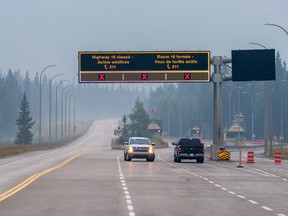The extreme winds, low humidity and high temperatures were the main factor driving the fire, says a University of Alberta professor
Article content
OTTAWA – Vast stands of dead trees ravaged by the mountain pine beetle that surrounded the townsite in Jasper National Park may have been a contributing factor to the devastating blaze that destroyed hundreds of homes, say forest scientists, but ultimately not as pivotal as the high winds, hot temperatures and overall dry conditions.
“You’re going to get a high intensity crown fire under those conditions, with or without mountain-pine-beetle kill,” said Jen Beverly, an associate professor at the University of Alberta.
Advertisement 2
Article content
Beverly said trees attacked by mountain pine beetle become most flammable a year or so afterward, but less so after the needles fall and the tree dies. She said even a healthy forest without dead trees would likely have been consumed by this week’s fire.
“When you have extreme wind conditions driving a fire in an area with continuous fuels, there’s very little you can do to stop that,” she said.
The forests in the national park have been ravaged by mountain pine beetles over the last 20 years. The insects leave pine trees dead, dried out and turning red all over the landscape. At the peak of the scourge, it was estimated the beetles had reached 98 per cent of the park, but in 2019 a cold snap killed off almost all of the beetles.
This week’s fire, which officials said burned an estimated one-third of the structures in the town of Jasper, began Monday evening and spread more than 10 kilometres before entering the community.
Beverly said Jasper’s location, at the centre of three mountain valleys, was a well-known risk factor for town officials and for Parks Canada, and it seems as if the worst-case scenarios had finally come to pass.
Article content
Advertisement 3
Article content
“The unthinkable — that you would have two fires coming from two of those valleys, at the same time — played out. But this is not something that they hadn’t thought about, and they had been planning for.”
But Parks Canada has been criticized in the past for not clearing dead trees or doing more prescribed burns to limit the fuel available for a forest fire.
W.J. Byrne, a former deputy minister of Alberta Community Development and of Alberta Advanced Education, wrote in the Edmonton Journal this week that the province’s officials previously argued with the federal government, which oversees national parks including Jasper and Banff, that it was not doing enough to thin old, flammable forest the parks.
“I believe that a major part of the immediate problem in Jasper — which could have been considerably mitigated in all of the Rocky Mountain national parks — is the Parks Canada ‘green’ policy of protecting the forest in all of the Rocky Mountain national parks,” he said.
Alberta Premier Danielle Smith said preliminary numbers indicated 358 structures in the Jasper community had been destroyed in the fire, which is still considered to be out of control.
Advertisement 4
Article content

Recommended from Editorial
Patrick James, an associate professor at the University of Toronto’s graduate school of forestry, agreed that trees damaged by pine beetles can contribute to fires, but in such extreme conditions that wouldn’t be a major factor, he said.
“The fire weather, as I understand it, for that Jasper fire was incredibly high, incredibly strong winds, very dry conditions, very little humidity. And what those extreme fire weather conditions do is they make the role of fuels actually not that important,” James said.
“I don’t think pine-beetle kill really played a role in this fire. I think this was an extreme heat, extreme wind, that really drove this fire to be as destructive as it was,” he said.
Alberta has been experiencing an extended drought period, and the last few weeks have seen hot summer temperatures.
James said logging and prescribed burns can reduce the amount of fuel available and the risk, but residents living in nearby mountain areas often don’t want them because they worry about the the burns getting out of control, which is more likely with warmer, drier weather.
Advertisement 5
Article content
“You can’t do these burns if there’s the potential for them to escape control,” he said.
At a Friday afternoon news conference, Jasper Mayor Richard Ireland said the community and the park had prepared for fire and built fireguards, but he added that people in his community want to live with much of the natural environment intact.
“It is our home and our recreation and we want to be in the mountains. We want to be in nature And that means our community is exposed to the threat of wildfire,” he said.
“What we could do to protect the town was done and yet, as humans, we stand humbled in the presence of nature. This fire was enormous. It was fast-moving.”

Federal Emergency Preparedness Minister Harjit Sajjan said the community had an extensive FireSmart program, which aims to clear trees and brush from around buildings. But he said the fire was throwing embers for distances greater than a kilometre at the peak of the blaze.
“What type of preparation do you need for something like that, when it’s a kilometre long, where embers are flying that much?” Sajjan said.
Alberta Minister of Public Safety and Emergency Services Todd Loewen said the province intends to look at the issue more deeply and things will need to be done differently to avoid this happening again.
Advertisement 6
Article content
“Albertans love the way the forest looks right now in their community and they don’t want it to change, but that’s not realistic. That forest will change and it’ll change either by us changing it or by a devastating wildfire coming through,” he said.
National Post
rtumilty@postmedia.com
Get more deep-dive National Post political coverage and analysis in your inbox with the Political Hack newsletter, where Ottawa bureau chief Stuart Thomson and political analyst Tasha Kheiriddin get at what’s really going on behind the scenes on Parliament Hill every Wednesday and Friday, exclusively for subscribers. Sign up here.
Our website is the place for the latest breaking news, exclusive scoops, longreads and provocative commentary. Please bookmark nationalpost.com and sign up for our daily newsletter, Posted, here.
Article content








